 Weird Stuff
Weird Stuff  Weird Stuff
Weird Stuff  Mysteries
Mysteries 10 Tragic Disappearances and Deaths in Joshua Tree National Park
 History
History 10 Ways Childhood Really Sucked in the Old West
 Music
Music 10 Name Origins of Famous Bands from the 1990s
 Religion
Religion 10 Biggest Turnarounds by the Catholic Church
 Weird Stuff
Weird Stuff 10 Unbelievable Times Laws Had Unintended Consequences
 Humans
Humans Ten Historic Women Who Deserve Way More Credit Than They Got
 Movies and TV
Movies and TV 10 Films That Spawned Major Lawsuits
 History
History Ten Times Towns Were Wiped Off the Face of the Earth
 Creepy
Creepy 10 of the Most Disturbingly Haunted Public Houses in the UK
 Weird Stuff
Weird Stuff 10 Niche Subcultures That Are More Popular Than You Might Think
 Mysteries
Mysteries 10 Tragic Disappearances and Deaths in Joshua Tree National Park
 History
History 10 Ways Childhood Really Sucked in the Old West
Who's Behind Listverse?

Jamie Frater
Head Editor
Jamie founded Listverse due to an insatiable desire to share fascinating, obscure, and bizarre facts. He has been a guest speaker on numerous national radio and television stations and is a five time published author.
More About Us Music
Music 10 Name Origins of Famous Bands from the 1990s
 Religion
Religion 10 Biggest Turnarounds by the Catholic Church
 Weird Stuff
Weird Stuff 10 Unbelievable Times Laws Had Unintended Consequences
 Humans
Humans Ten Historic Women Who Deserve Way More Credit Than They Got
 Movies and TV
Movies and TV 10 Films That Spawned Major Lawsuits
 History
History Ten Times Towns Were Wiped Off the Face of the Earth
 Creepy
Creepy 10 of the Most Disturbingly Haunted Public Houses in the UK
10 Brutal Attacks On Prisoners By Prison Guards
Prison can be deadly for its inhabitants. Many people assume that prisoners are the only ones who engage in violent activity and the only ones who kill behind bars. But that’s not always the case.
Guards can easily lose their tempers when dealing with unruly or mentally disturbed inmates, and they can frequently attack the prisoners without any repercussions. Each of the following inmates was treated horrifically before dying from injuries inflicted by the guards.
10 Ronald Spear
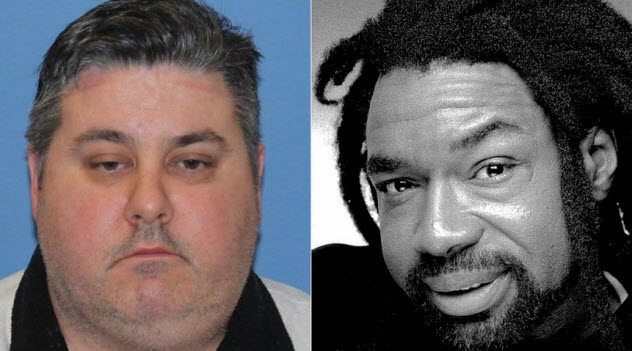
Fifty-two-year-old Ronald Spear went to buy medicine at a store in Harlem, but he had forgotten that he was barred from the store because of an earlier shoplifting charge. He was arrested and taken to jail. Spear was put into the infirmary unit as he had diabetes, heart disease, and end-stage renal disease that required dialysis. He used a cane to walk, and he wore a bracelet that warned he was at risk of falling.
Spear spent several days demanding to see a doctor. Finally, he would not take no for an answer. He tried to push past a guard, Brian Coll, who punched Spear in the face and stomach. Two other officers tackled Spear, and they pinned him facedown on the ground.
Coll kicked Spear several times in the side of the head “like he was kicking a field goal.” One of the guards tried to shield Spear’s head with his hand, and he shouted at Coll to stop. Coll leaned forward, pulled up Spear’s head, and said, “This is what you get for f—king with me, remember I did this.” Then he dropped Spear’s head to the ground.
Spear did not move. The beating had caused bleeding in his brain, and his heart had failed. The officers immediately began a cover-up. Coll convinced the others to tell their captain that Spear had attacked Coll with a cane.
A couple of years passed, and one of the officers, Anthony Torres, became overwhelmed with guilt. He confessed to his role in the murder. Police arrested Coll, and they discovered a framed news article about Spear’s death in his bedroom. Coll was found guilty of Spear’s death and sentenced to 30 years in prison.
Spear’s family sued New York City and received $2.75 million.[1]
9 Michael Tyree
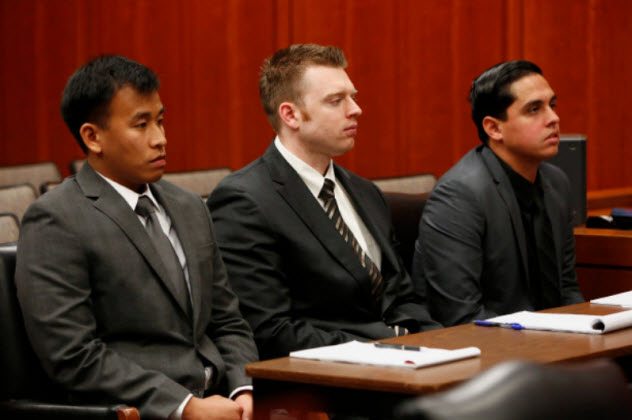
After Michael Tyree violated probation for a minor drug charge, a judge ordered him detained until he could be placed into a treatment center for the mentally ill. Tyree, who suffered from bipolar disorder and addiction, was housed in a section of the jail reserved for inmates who have special needs.
Tyree refused to take his medication. He pocketed his pills and argued with the nurse. The nurse called a guard, and they were able to convince Tyree to take his medication without incident.
The guard returned to Tyree’s cell later that night with two of his friends. They were angry at Tyree for the way he had spoken to the nurse, so they attacked him. The guards stomped on Tyree at least once, and they struck him repeatedly. Numerous inmates heard Tyree screaming, “I’m sorry. I’m sorry. Stop.” They left Tyree crumpled on the floor.
Jail staff discovered Tyree dead in his cell hours later. His naked body was smeared with vomit and feces. An autopsy showed that Tyree had died from massive blunt force trauma that had caused his liver and spleen to rupture. He had died within minutes of the beating.
Police arrested the three guards: Jereh Lubrin, Matthew Farris, and Rafael Rodriguez. They looked though the men’s text messages and discovered that the guards had often boasted of beating inmates in areas of the jail without security cameras.
The guards also expressed humor and enjoyment at the pain or discomfort experienced by the inmates, especially mentally ill prisoners. The guards were found guilty of second-degree murder, and they were sentenced to 15 years to life in prison.[2]
County officials paid $3.6 million to Tyree’s family to settle a wrongful death lawsuit.
8 Randall Jordan-Aparo
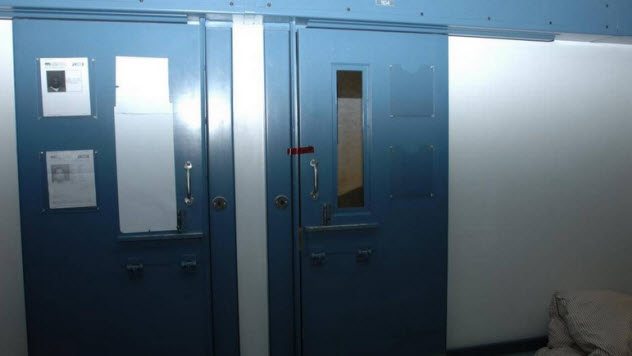
Randall Jordan-Aparo was serving time for credit card fraud. Several months into his sentence, Jordan-Aparo began suffering from complications from his genetic blood disorder. Medical staff refused to help him. When he told them that he had blood in his mouth and urine, the nurse threatened to file a disciplinary report.
After his symptoms worsened, a nurse contacted the prison doctor, who told her to start an intravenous application and keep him in the infirmary. The nurse tried to insert the IV, but she gave up after several unsuccessful attempts. She left Jordan-Aparo in the infirmary overnight.
The next morning, two nurses examined him. He said that he was in pain and needed to go to the hospital. They refused, and he screamed, “I am going to sue your f—king ass. I need to go to the hospital!”[3]
A nurse called the prison guards. Without consulting a doctor, the guards decided to remove Jordan-Aparo from the infirmary and place him in an isolation cell. He was then gassed with 600 grams of chemical agents, well over lethal levels. Inmates in the area heard him scream: “I can’t take it. I can’t take the gas. I need a nurse!”
Jordan-Aparo was dragged to a shower. He emerged still covered in the toxic orange residue from the chemicals and was so weak that he had to be put in a wheelchair. They brought him back to the isolation cell, which was covered in residue from the gases.
Jordan-Aparo was found dead hours later. His body was on the floor of the cell, and his face was pressed against the door as though he had tried to get fresh air through the narrow crack beneath the door.
No one was charged in his death.
7 Matthew Walker
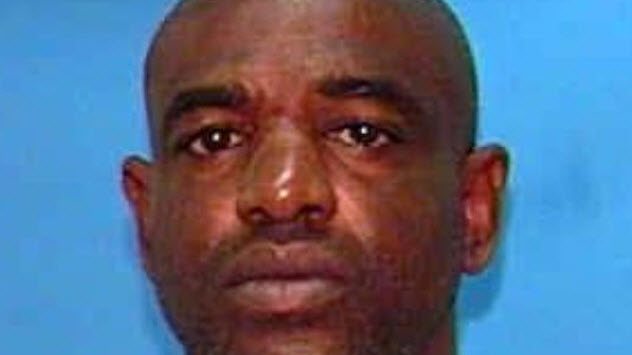
Matthew Walker, who was serving a 20-year sentence for burglary and assault, was awakened around midnight because a cup and magazine were out of place in the cell he shared with another inmate. Walker said, “This is crazy. You are waking me up about a cup.” He refused to move the items. The corrections officer called for backup, and several guards arrived.
They ordered Walker’s cellmate out of the cell, and he watched the guards attack Walker. One of the officers pulled out a canister of pepper spray and sprayed it toward Walker. Then the brawl moved to the hallway outside. Inmates watched officers punch, strike, and kick Walker.
The guards handcuffed Walker and tried to carry him away. One of them noticed that Walker’s pupils were not responding and called for medics. An officer assisting in the medical response said that Walker’s “head felt like Jell-O [and] they must have kicked his ass.” Walker was soon pronounced dead.[4]
The medical examiner discovered that Walker’s larynx had been crushed so badly that his throat had swollen shut and he had suffocated. His body also showed evidence of at least 11 separate traumas.
No one was charged in Walker’s death.
6 Samuel Harrell

Samuel Harrell, an inmate who suffered from bipolar disorder, packed his bags and announced that he was going home even though he still had several years left to serve on his drug sentence. Then Harrell ran headfirst into a locked exit door.
Several corrections officers confronted Harrell, and he was thrown to the ground and handcuffed. As many as 20 officers—including members of a group known around the prison as the “Beat Up Squad”—repeatedly kicked and punched Harrell while shouting racial slurs. Harrell was then thrown or dragged down a staircase. One inmate reported seeing him lying on the landing, “bent in an impossible position.”
Corrections officers called for an ambulance, but they did not mention the beating. Instead, they told the ambulance crew that Harrell had probably overdosed on synthetic marijuana. He was taken to the hospital, where he was pronounced dead.
An autopsy report concluded that Harrell had cuts and bruises to the head and extremities and that he had no illicit drugs in his system. He had died of cardiac arrhythmia “following a physical altercation with corrections officers.”[5]
No one was charged in his death.
5 Martin Harrison
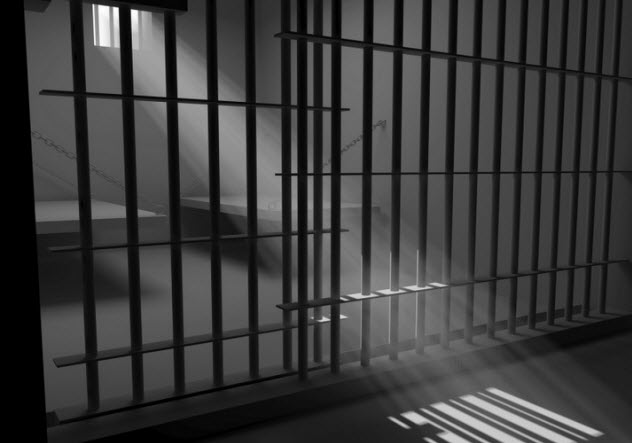
Martin Harrison was arrested on a warrant for failure to appear in court for a DUI charge. When he was brought to jail, he told the nurse that he drank every day and had a history of alcohol withdrawal. Initially, the nurse decided to put him on alcohol withdrawal protocols. Then she changed her mind and sent him into the general population with no medical follow-up.
Harrison began to suffer from a severe form of alcohol withdrawal known as delirium tremens. He started to hallucinate and act erratically. He began screaming, broke a food tray, and flooded his cell by overflowing his toilet. Deputies went into his cell and found him hiding behind a mattress. Harrison told them that someone was trying to kill him. Then he charged at them.
In the ensuing struggle, 10 deputies punched and kicked Harrison and repeatedly shocked him with Tasers. When Harrison was finally subdued, deputies took him to another cell and restrained him with a waist chain, leg shackles, handcuffs, and a spit hood.
A nurse examined him soon after the struggle. Harrison fell unconscious during the examination and never woke up. He died two days later at a hospital. A coroner’s report found that Harrison had died after suffering “cardiac arrest following excessive physical exertion, multiple blunt injuries, and Tasering.”
Investigators discovered that the prison’s health care provider, Corizon, had hired significantly cheaper licensed vocational nurses instead of the registered nurses required by the state. Harrison’s family sued Corizon and the county, and they received $8.3 million.[6]
4 Richard Metcalf
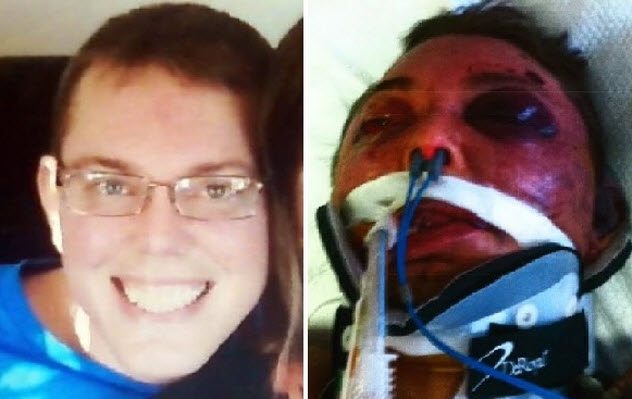
Richard Metcalf had never exhibited any signs of mental illness until he left his home early one morning, ran through the snow barefoot, and attempted to break into the catering business where he worked. When police confronted Metcalf, he resisted and was Tased twice.
Metcalf was taken to a holding cell and held for an arraignment. He had soiled himself before the transport and needed a shower when he arrived. Officers said that Metcalf “freaked out” after he was taken to the showers, and they had to “take him down” to control him. Metcalf was brought to the medical center, where he told doctors that “he got beat up in jail.”
Metcalf was taken back to the holding center, where his behavior and the beatings worsened. Officers reported that he was acting irrationally in his cell, biting and punching himself, and banging his head on the cell bars.
Officers restrained Metcalf, shackling his hands and ankles. He began spitting blood, and the officers placed a spit mask on Metcalf. The inmate chewed through it, so they placed a pillowcase over his head.
Officers called for an ambulance. When the medics arrived, they attempted to remove Metcalf’s spit mask. It was so tight that they needed scissors to remove it. They discovered that Metcalf was not breathing. He had asphyxiated because the strings of the spit mask were knotted tightly around his neck rather than the back of his head.
Emergency room doctors managed to bring him back, but he was brain-dead. The doctors discovered that Metcalf had bruises all over his body and four broken ribs. His organs had also begun to fail.[7]
No one was charged in his death.
3 Leonard Strickland
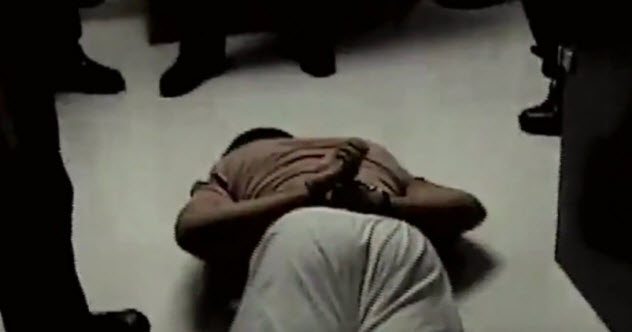
Leonard Strickland, who suffered from schizophrenia, was convicted of criminal possession of a weapon and sent to prison. Strickland got into an argument with prison guards which turned violent. The guards claimed that they acted in self-defense. However, six inmate witnesses, who were all interviewed separately, described a horrific attack against Strickland.
He was beaten by one of the guards and pushed down a flight of stairs by an officer who yelled a racial slur. As Strickland fell down the stairs, his skull hit the concrete steps several times. At the bottom of the stairs, he pulled himself into a tight fetal position while several officers took turns kicking him in the head and ribs.
Strickland was brought to the prison emergency room to be examined. Video shows Strickland barely standing before he slumped to the floor. After five minutes, the guards decided to take him upstairs to the mental health ward. Two officers grabbed Strickland by his arms, which were still handcuffed, and lifted them until they were hyperextended behind his head. Then they dragged Strickland out of the room.
The officers dropped him facedown in a hallway, and Strickland remained on the ground for nearly 10 minutes. The officers noticed that Strickland was not breathing, so they performed CPR. An ambulance crew arrived, and Strickland was brought to the hospital where he was pronounced dead.[8]
No one was charged in his death.
2 Larry Trent

Fifty-four-year-old Larry Trent was arrested for a DUI. He could not post bond, so he remained in custody. Four days later, two guards, William Howell and Damon Hickman, opened the door to Trent’s cell to remove a sleeping mat and Trent ran out of the cell.
Howell used a Taser on Trent. While Trent was lying unresponsive on the ground, Hickman kicked Trent in the ribs. The two deputies carried the inmate back to his cell, and Trent took the Taser from the deputy jailers. They took back the Taser and restrained Trent on the floor. Then Howell and Hickman punched, kicked, and stomped on Trent, leaving visible boot prints on Trent’s torso and face.
Before the deputies closed the cell door, Howell stepped into Trent’s cell and kicked Trent in the head while he was lying on the floor. The guards’ assault had left Trent’s blood in the hallway and booking area as well as on the deputies. Howell and Hickman ordered other inmates to clean up Trent’s blood from the floor and the walls outside his cell.
Trent was left lying motionless on the cell floor, seriously injured and bleeding from an open head wound. The deputies did not seek medical attention for Trent because they were afraid that they would get in trouble.
Another employee noticed Trent’s lifeless body roughly four hours after the beating. He called emergency personnel, and Trent was pronounced dead at a local hospital that afternoon. Autopsy results showed that Trent died of a pelvis fracture that caused hemorrhaging and from blunt force trauma to his head, torso, and extremities.
Howell was convicted of charges of excessive force, deliberately ignoring serious medical needs, and obstruction of justice. Hickman pleaded guilty and was sentenced to 10.5 years in prison.
Trent’s family sued the jail, and they received $2.375 million.[9]
1 Darren Rainey
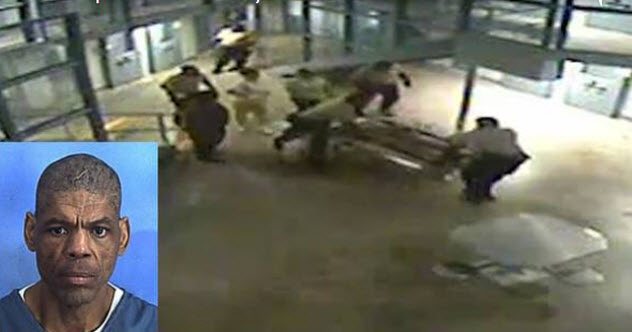
Fifty-year-old Darren Rainey was serving a two-year sentence for cocaine possession. Four months into his sentence, Rainey, who suffered from schizophrenia, soiled himself in his cell and refused to clean up. Correctional officers escorted Rainey past several operable showers. Instead, they brought him to a special one that had been rigged so that its temperature controls were in an adjoining janitor’s closet.
The officers threw Rainey a bar of soap, locked the door, and then turned on the water. The temperature was cranked up to more than 71 degrees Celsius (160 °F)—far beyond the state’s maximum of 49 degrees Celsius (120 °F).
According to Rainey’s fellow inmates, the officers laughed and taunted Rainey as he begged for forgiveness. Then the officers left. When they returned nearly two hours later, Rainey was dead. His skin was so burned that it had shriveled from his body, and pieces of his skin were floating in the water. Inmates were ordered to clean up the shower. They were also told to never speak about what had happened or they would end up like Rainey.
The prison’s medical examiner claimed that Rainey had not suffered burns of any kind and said that there was no evidence of any trauma on his body. However, a never-released preliminary report written the day of the autopsy refers to “visible trauma . . . throughout the decedent’s body.” A nurse later told journalists that Rainey’s body temperature that night was so high that it could not be measured with a thermometer.
Rainey’s official cause of death was complications from schizophrenia, heart disease, and “confinement to a shower.” His death was ruled an accident. No one investigated Rainey’s death for years until a fellow inmate contacted a newspaper. Several prison officials were fired after the stories were published. However, no one was charged in his death.[10]
Rainey’s family sued the state of Florida and others, and they received $4.5 million.
For more brutal stories about prison, check out 10 Brutal Realities Of Living In Solitary Confinement and 10 Ways Prisons Torture Inmates In Modern Times.








